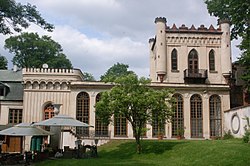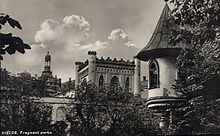Zieliński Palace (Kielce)
The Zieliński Palace in the Polish city of Kielce is named after Tomasz Zieliński (1802–1858) and is located in the city center. The building complex with neo-Gothic elements is part of the former episcopal residence complex in Kielce. It is located on Zamkowa Street between the former Bishop's Palace (in the north) and "Stanislawa Staszica Park" (in the south). It is directly adjacent to the former prison and is now used as "Dom Środowisk Twórczych" ( House of Artists or House of Art [precisely: House of the Artistic Environment ]).
ensemble
The complex consists of the older main house, which is adjoined by a neo-Gothic extension in an easterly direction. The extension consists of a tower building with a staircase and a connecting, small orangery . The design of the building also contains elements of classicism and neo-renaissance . Overall, this creates a romantic overall effect.
Inside the palace there is now a concert hall, a club hall, the “Poniatowski” and the “Portrait Hall”, a café / restaurant, a library and the orangery. In the adjoining park-like garden there is a one-story building with a wooden portico and a commemorative column dedicated to artists of the 19th century. An outside cafe is operated here in the summer months. The garden is separated from the “Stanislaw Staszica Park” by a wall that is partially provided with battlements, loopholes and a stylized defensive tower (“Plotkarka”, in German: rumor teller ).
To the west, the rear garden is closed off by another building belonging to the ensemble. There are modern sculptures in the front garden.
history
The palace stands on the site of the former manor of the episcopal building complex. Up until the 18th century, the episcopal laundry, stables and a riding school were located here. The first buildings existed on the site as early as 1587; the predecessor of today's palace was probably a wooden storage building, which was later replaced by a brick building. Foundations and walls up to 1.20 meters thick on the ground floor can be found in today's palace. The house and the attached stables fell to the Mining Academy in 1819 when the episcopal property was moved into the hands of the Royal Council of Poland.
From 1841 the building was handed over to Janusz Trzetrzewiński , the then President of the “Society of Civil Court” of Kielce ( Towarzystwa Trybunału Cywilnego w Kielcach ). In the following year it came into the possession of the bank director Andrzej Suchecki, who probably had it expanded. From him, the Kielc District Administrator Tomasz Zieliński bought the property on June 1, 1847. By 1851 he had the building renovated.
Under Zieliński, who was a great collector and promoter of art and culture, the property became a center of Kielc cultural workers. Artists such as Józef Szermentowski , January Suchodolski , Wojciech Gerson and Franciszek Kostrzewski (1826–1911, was a Polish painter, draftsman and caricaturist) frequented here. A museum was created. Zieliński had a romantic park laid out and designed the building facade facing this garden as well as elements of the garden wall in the style of neo- and pseudo-Renaissance (this included the “Plotkarka” and loopholes).
After Zieliński died in 1858, the property passed to his wife Teofila. She bequeathed the palace to her brother Ludwik Andrzej Pietka, who lived in Warsaw, who sold the property to the Kielc doctor Stefan Łuszczkiewicz in 1868. The next owners were the Antecki couple. In 1907, the glassworks owner Izydor Władysław Ziembiński bought the property from them.
After partial renovations and a deterioration of the building fabric in the 1920s, work began as early as 1935 to restore the condition of the Zieliński era. In 1972 the Club of Art Associations ("Klub Związków Twórczych") was housed. Since 1985 the palace has been the seat of the Kielcer Künstlerhaus ("Domu Środowisk Twórczych"). Concerts, exhibitions and conferences are held here today. A restaurant is operated and guest rooms are offered.
Web links
- Satellite image on Google Maps
- Website of the Dom Środowisk Twórczych in Kielce
Individual evidence
- ^ Creative Environment House and the Municipal Park, Kielce, Poland. at Odyssei.com (English).
- ↑ ( Page no longer available , search in web archives: Kielce - The capital of the region. ) At Sejmik.kielce.pl.
Coordinates: 50 ° 52 ′ 5.2 " N , 20 ° 37 ′ 33.2" E





